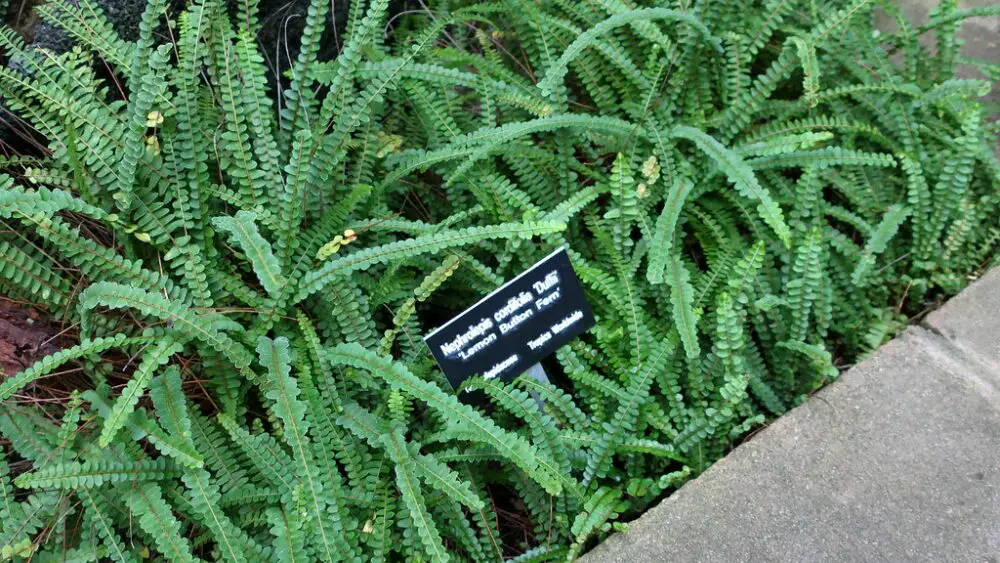The Nepholepis cordifolia or lemon button fern is one of the easiest and cutest plants to care for. Novices and pro botanists alike can add the lemon button fern to their hardy plant list. Combined with its mild lemony scent during its active growing months, it's no surprise that this edible houseplant is so popular.
Nephrolepis Cordifolia: Plant Profile
You might have heard of the Nephrolepis cordifolia‘s sibling, known by its synonym Boston fern.
With small, round leaves and a unique lemon aroma when crushed, the lemon button fern is one of the prettiest plants you’ll find.
Perhaps you’ve heard of Nephrolepis cordifolia before by one of its common names or synonyms.
What Are You Foraging For Right Now?
We're thrilled to hear your ideas. What would you like to submit today? Feel free to share your thoughts and experiences with us.
These include:
- Lemon button fern
- Erect sword fern
- Fishbone fern
- Tuber ladder fern
- Tuberous sword fern
- Narrow sword fern
- Herringbone fern
- Ladder fern
It’s common to find the names of the Nephrolepis cordifolia interchange among the species of this USDA plants. For example, the tuberous sword fern is readily confused and sometimes sold in stores as the native sword fern.
Always ensure you’re taking the right plant home for clarity and the best chance of growing success.
How to Identify Lemon Button Fern (in Comparison to Other Ferns)
Because of this confusion between the vast varieties of ferns, you need to know how to identify the Nephrolepis cordifolia.
Lemon button fern is a top option as a stunning, leafy, deep green plant that helps purify and brighten up any room and can be ground cover in the right conditions.
One of the easiest ways to identify the lemon button fern is to crush or rub its leaves. Doing so releases that mild but distinct lemon scent (if it’s not already giving off a lemon scent).

Where does Lemon Button Fern Grow?
When out foraging in the conservation areas of California, Florida, all the way to Alabama and Georgia, you might find the lemon button fern in cultivation on:
- Roadside
- Flatwoods
- Rock lands
- Marsh edges
- Hammocks
Kupukupu, Okupukupu, and Ni’ani’au are some common names given to Nephrolepis cordifolia in its native, indigenous Hawaiian islands.
This type of sword fern is also native to north-eastern Australia. New South Wales’s central east coast gives it the status of naturalized.
Is Lemon Button Fern Edible?
While it’s true that many fern species contain useable rhizomes (otherwise known as creeping rootstalk), only two types of Nephrolepis have tubers.
The good news is that these are the Nephrolepis cordifolia and Nephrolepis undulata.
But what does this mean?
The lemon button fern or Nephrolepis cordifolia is edible.
The roots are used for cooking but can be eaten raw as well. Similar to Jerusalem artichokes, the roots are sweet and crunchy with an earthy taste.
You can roast large roots in an oven just to get sweet and chewy lumps. Small roots are known to turn to a powder inside, resembling the taste of coffee.
Happy days.
Is Lemon Button Fern Poisonous to Cats and Dogs?
There’s more good news for pet lovers galore. No, according to reports from the ASPCA, Nephrolepis cordifolia is non-toxic.
It’s not poisonous to dogs and cats.

Is it Easy to Grow?
One of the best things about the Nephrolepis cordifolia is how hardy and forgiving it is. This sword fern is perfect for the self-sustaining plant ecosystem of terrariums.
If you’ve accidentally killed all your other ferns, despite your best efforts, then the Nephrolepis cordifolia may be the right plant for you.
This cute and compact fern is more resilient and relaxed than its fern relatives in the Nephrolepidaceae family. The fern is incredibly easy to care for and grow, so why not give it a go?
If your lemon button fern gets entirely out of hand, you can trim it or propagate it to give to friends and family.
But there can be times when your lemon button fern needs extra help. Try the below tips to solve some of its most common problems.
Fixing Common Problems when Growing Lemon Button Ferns
- Try to avoid overwatering or excess sun when wilting leaves present themselves. If you’ve also got mushy stems, you’ve overwatered your fern.
- Yellowing leaves means again too much sun or too much water. Never wholly saturate the soil when watering, and never leave your fern in direct sunlight.
- In contrast, brown and crisp fronds could signify that your lemon button fern is lacking in water or humidity. Try to water your fern regularly. You can also use a humidifier or pebble tray to increase the moisture.
- Keep an eye on the growth of your lemon button fern. As a slow-growing houseplant, you shouldn’t expect noticeable growth immediately. As long as your fronds loss is no more than you gain each year, you’re fine.
So, there you have it. Lemon button ferns are low maintenance, hardy, attractive plants worth planting, even for a beginner botanist.
Getting into the great, wet outdoors in search of edible plants, herbs, fruits and fungi is one of Sarah’s favorite outdoor pursuits. She thinks there’s nothing better than combining her passion for hiking with the start of the foraging season. Sarah’s definitely not afraid of a little rain and dirt, it’s all part of the fun.

